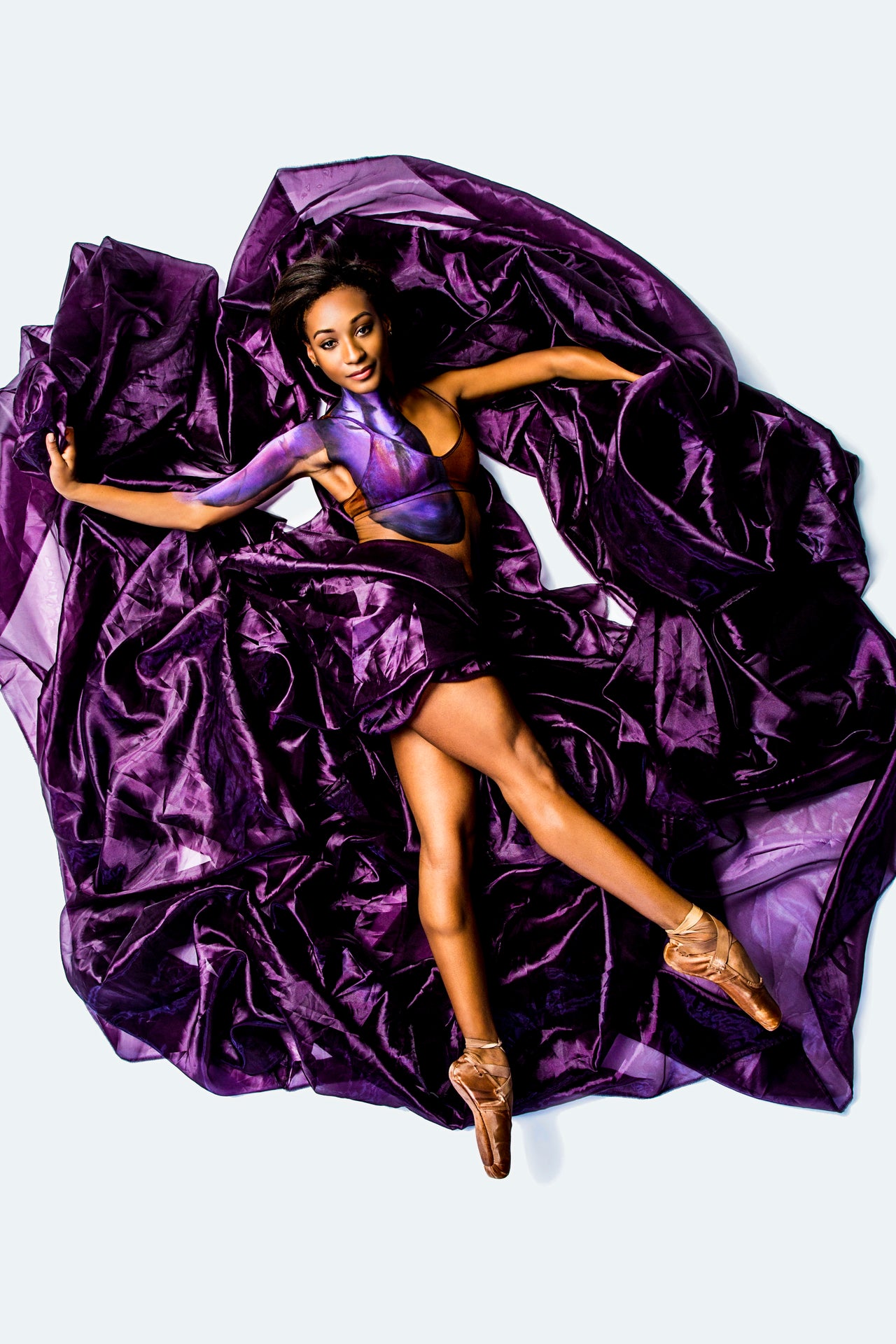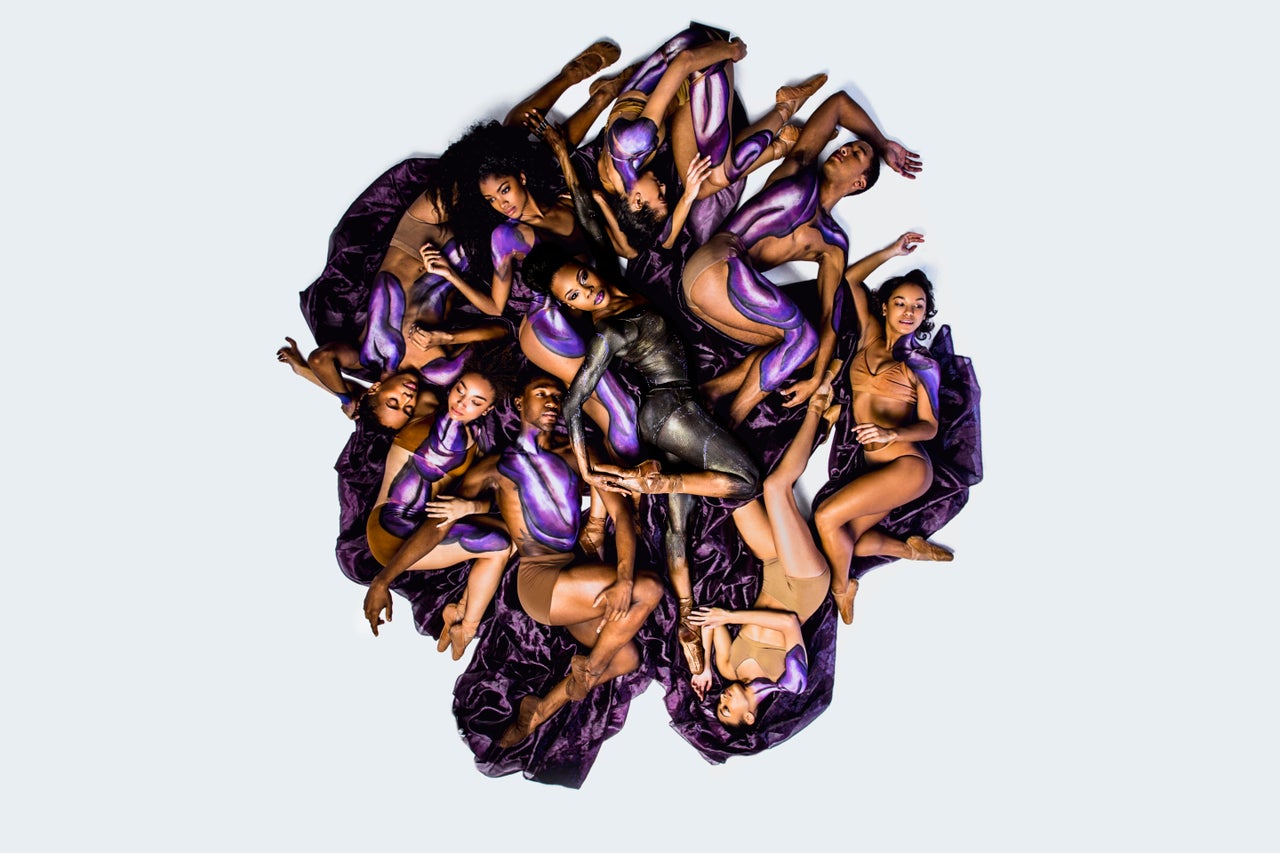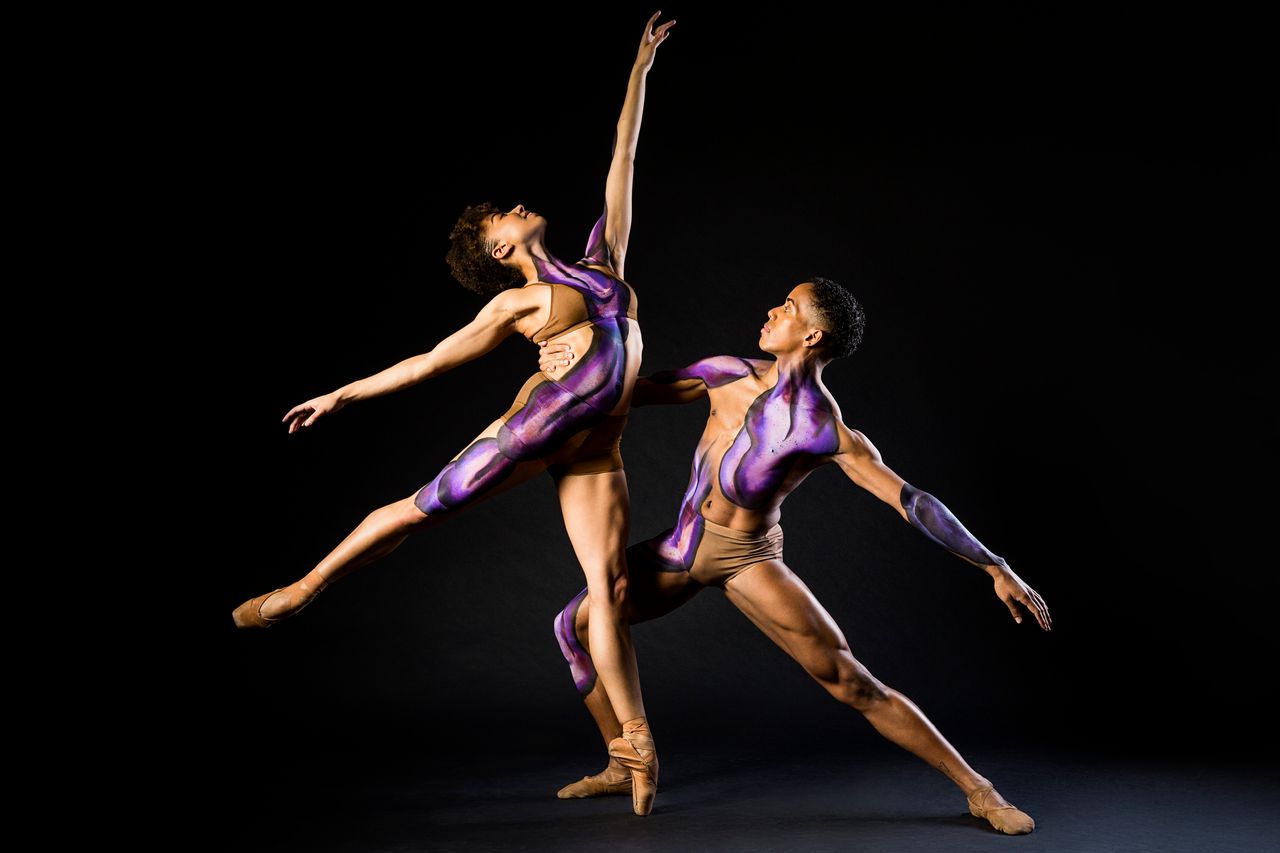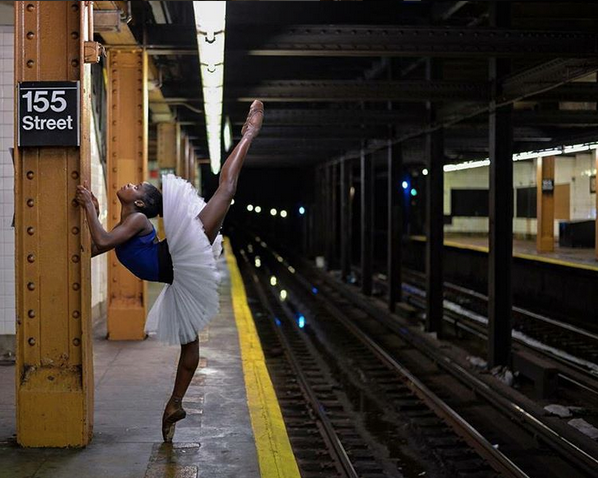Choreographer Jeremy McQueen founded the Black Iris Project in the early months of 2016, though the idea behind the dance initiative took root a few years before.
Back in 2013, McQueen was working with the Joffrey Ballet under the prestigious Choreographers of Color prize when he imagined "Black Iris" as a performance exploring black womanhood through dance. He was inspired in part by his mother, as well as by the journeys of other black women like Washington Ballet dancer and "Black Iris" performer Nardia Boodoo. Both had fought against the odds; McQueen's mother in her battle against breast cancer, Boodoo in a ballet career historically dominated by lithe, white bodies.
After his work on "Black Iris," McQueen -- who's trained at the California Ballet School, the San Diego School of Creative and Performing Arts, the San Francisco Ballet, the American Ballet Theatre, and Alonzo King’s LINES Ballet; not to mention taught at the Peridance Capezio Center, Alvin Ailey Dance Foundation, Steps on Broadway, and a number of other schools and studios -- found himself wanting another opportunity like it, another chance to not only showcase the talents of other dancers of color, but to tell stories that reflect the experiences of people of color, too.
"I wanted to create more opportunities like this one for collaboration, reflection, connection," McQueen told The Huffington Post, "and the creation of dynamic works of art that address the black experience or black history. We wanted to develop works of art that our communities would specifically find interesting and would want to see them performed."
So he made another opportunity happen. With grants from the Rockefeller Brothers Fund, New Music USA and the CUNY Dance Initiative, the "Black Iris" performance became the Black Iris Project, which has since brought together 20 dancers of color from a variety of companies, including Stephanie Rae Williams, Daniel Harder, Ebony Williams, Erica Lall, Camille Workman, and Da'von Doane. Described as "a ballet collaborative and education vehicle which creates new, relevant classical ballet works that celebrate diversity and black history," the New York City-based project spotlights a growing roster of predominantly minority artists with the aim of inspiring youth of color to explore the arts.
It was only last year that Misty Copeland became the first African-American ballerina to achieve the rank of principal dancer at ABT, and while there's a long history of black ballerinas succeeding in the dance world in a field that's favored thin, light-skinned bodies on stage, dancers and choreographers of color are a minority. We spoke with McQueen more about the beginnings of his project and what it means to use art as a platform for celebrating diversity:
Tell me about "Black Iris" at the Joffrey Ballet. How did the Black Iris Project transform from an en pointe ballet to a broader organization?
My mother informed me that she was diagnosed with breast cancer just before a visit to the Metropolitan Museum of Art with a friend. While touring the museum, I fell in love with a painting entitled "Black Iris III" by Georgia O'Keeffe. It sent lightning bolts to my heart in ways that no piece of art ever had before. Around this same time, I was in the process of applying for the Joffrey Ballet's Choreographers of Color Award and was preparing to write a proposal of the type of work I would create. While thinking more about this painting and knowing how I was feeling about my mother, it all just clicked... I needed to find a way to release this frustration, sadness and confusion through art. So I took to my pen and paper and just wrote and listened to music and took long showers. (I have discovered that most of my ideas come when I'm in the shower.)
Next, I found out that I was a recipient of the award. I knew I wanted to create this ballet as a tribute to my mother, but it wasn't at all a priority for the lead in my ballet to be black. I studied in dance schools for many years where I was often one of few black dancers, so I knew what my odds were that I would even have anyone of color in my ballet. When I arrived to the Joffrey Ballet, I fell in love with Nardia Boodoo. She struck me like the painting. She had a quiet confidence that reminded me of myself, and I saw something in her that told me I needed to take a chance on her. After I became better acquainted with her, I started to look at her journey and the journeys of other black women around me. I started to see some fundamental similarities. So the piece went from being a tribute to my mother and the other women who helped raise me to a tribute to black womanhood in general.
From there, Nardia and I built a bond along with Pierre Lockett (former dancer with the Joffrey Ballet). Pierre became a big brother to me. We created a support system for each other, and we each shared our stories in an effort to help strengthen one another ... I wanted to create more opportunities like this one for collaboration, reflection, connection, and the creation of dynamic works of art that address the black experience or black history. We wanted to develop works of art that our communities would specifically find interesting and would want to see them performed.

What is the process like of creating a new ballet through the Black Iris Project today? Who are the people typically involved in a production?
Within our debut season, we have two new ballets we've been developing. The first ballet is "Madiba," which highlights the faith and determination of South African anti-apartheid activist Nelson Mandela; the other work is entitled "Brown Baby," which is inspired by the true story of black model Beatrice Reynolds Cox and her evolution embracing her identity as a biracial woman.
With "Madiba," the new score of music came first. Last spring I stumbled upon Carman Moore's score, which had just premiered at Carnegie Hall. I was writing extensively at the time and thinking about black stories that I felt would make dynamic ballets and conversation/education pieces that people of all ages could continue to talk about that relate to either the black experience or black history. Nelson Mandela was not on my radar at all. But when I read about [Moore's] score -- and also realized it was composed by a black classical composer -- I had to hear it.
So, I reached out to him, we met, and I fell in love with the score. Through the score, the story was essentially laid out for me. It was very linear. I started to craft some ideas of how I would bring the story to life using the concrete moments that the composer utilized from Mandela's life for inspiration. I started pulling together a team of black designers. Since I didn't know of many emerging designers, I was on a quest to find some. After reaching out to my colleagues and asking for recommendations of emerging black designers from various mediums, the team for "Madiba" was built and we started brainstorming how we could bring this work to life in a dynamic and innovative way.
With "Brown Baby," it all happened differently. The idea for the ballet came first. I had been in consideration to create a piece for an organization last summer that would [focus on] an interracial relationship -- specifically, a white male and a black woman, and they wanted it to be en pointe. I found music that inspired me and played around with fictional and non-fictional storylines. My pitch was not greenlighted, and I wasn't commissioned to create the work. By the time I had come up with a complete idea, I loved it and couldn't get it out of my head.
So I started thinking about how I could still create this work on my own. I knew Lauren Cox through mutual friends and was friendly with her, but I was not very close in friendship with her. I really loved her movement quality. So, I reached out to her about a potential collaboration and told her about my interracial relationship idea. At that moment, she revealed to me the story of her mother who was biracial and how she became an amazing fashion model. The entire story was so inspirational and relevant to the times on how we look at beauty and how it must be found from within. When she embraced her uniqueness and beauty, others did as well. That's such a beautiful message, and I absolutely felt like this was the ballet we were destined to create. From there, I researched, wrote more ideas, and became smitten with Aaron Diehl's piano compositions. I contacted him, told him about my vision and mission. Months later, he created a brand new score for us.
It's been a mighty ride just to get to this point, but it's really been fulfilling. I look forward to sharing these works with the world and allowing them to have an impact in various communities to provide hope, motivation and encouragement to those who can relate to these truly beautiful stories of individuality.

Why do you personally think that ballet is a powerful platform for directly celebrating diversity and black history?
The arts, in general, are just so powerful. Ballet is an art form that, I believe, has a huge lack of diversity. Yet we have so many great black ballet dancers in companies around the country right now. I strongly believe that all art forms should be accessible to all people, and ballet in particular is one art form that I feel is very traditional and is often appealing to a certain demographic of people. So, my mindset is: Why not shake things up a bit?! We live in America, and we exist in a world with so many different backgrounds, beliefs, cultures, etc. I feel that ballet needs to reflect this as well.
So I don't see ballet as one art form that is a better platform over others, but I think there needs to be more diverse ideas on casting, and especially the types of stories that are told within ballet specifically. We're so used to the stories being European-rooted, or fables and fairytales in ballet. Unfortunately, most of the minority kids that I teach aren't interested in these stories, especially if they don't see someone who looks like them dancing the roles. Visibility is huge.
In many ways [ballet] is still very segregated. The idea that we shouldn't create black stories through ballet is weird to me. It's as if we as black people should cling more to modern and not to ballet. I don't believe that we should have such "social norms" in the 21st century. If we don't address this issue and change this, all we do is repeat a cycle of things changing a little bit, but at the same time not really changing. Instead of waiting for a company to do this, I decided to create the stories and the opportunities that I wish existed.

Your website states that the Black Iris Project "will encourage and inspire youth of color to pursue art, movement and music as an expressive outlet and means for collective healing." Can you expand on this idea?
Yes, we are joining forces as artists from various mediums not to necessarily push a ballet agenda and get minorities to necessarily want to become ballet dancers. We want them to see the arts as an amazing outlet of expression. Whether it be painting, playing or composing your own music, making up your own dances ... I know firsthand that art heals in unique ways.
I see all of this as group therapy. As we go out into the community and give back, we are able to connect with young people and to see their faces light up. Many stereotypes about minorities exist, especially about black kids from inner cities. My concern is that instead of judging these students and pointing fingers, we need to find better ways to reach them and to help them see value in their lives, no matter where they come from or what their circumstances may be. We must also see that the arts can be a creative and constructive way to heal, vent or express oneself without necessarily getting caught up in the wrong crowds or taking out their aggression and frustration with violence.
I have been so fortunate to have been able to study many art forms. The arts have kept me focused. It's given me drive and determination and a sense of individuality and independence. I've dealt with depression in the past. During those times, I could have easily resorted to drugs or violence as a way of trying to control my surroundings. Instead, I have had my art to rely on during those challenging times. When I was sad, I went to class and danced my heart out; sometimes I ended up crying while I did it. Every time I danced, I felt so much better. It was my release, and it helped me pick myself up and continue pushing.
Based on your experience educating through the Black Iris Project, what role do you think ballet training plays in the lives of young children?
I believe the arts, in general, play a powerful role in the lives of young children. The arts can help you in so many ways. Ballet teaches discipline. There's a protocol in ballet and being exposed to ballet and the arts at a young age can have a strong effect on young people's development.
What's next for Black Iris Project?
We have a slew of events in the city leading up to our debut season, but my major goal is to take these works on the road. I want to go into community centers and take these ballets directly to our targeted audiences. It's one thing if you invite people to come see what you have done, but you reach so many more if you take your art directly to their front doors.
Next April, we will be performing at the Kennedy Center Opera House as part of the Kennedy Center's Ballet Across America Series curated by Misty Copeland and Justin Peck. This is the first step in what I have in mind for The Black Iris Project. I can't share all of what's up my sleeve just yet. But look out for the BIP. We're in formation and ready to go!

